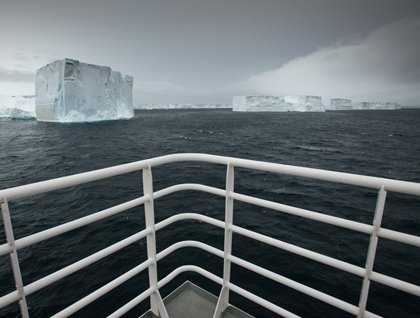For a lover of ice the last 24 hours could not have been better.
At 6:45 a.m., almost an hour before the scheduled wake-up call, we were roused with an invitation to come out on deck as we approached a wall of ice. This news came as a surprise. We had anticipated going ashore in the Antarctic for the first time this morning when an announcement revealed the winds were too strong on this wild, windy, eastern side of the peninsula and that we were changing course. The call came as we were retreating back north out of Antarctic Sound, at the extreme NE extent of the Peninsula, and just as we began to slalom through the broken up, grounded remains of iceberg B15Y. Yes, icebergs are so large in the Antarctic that they are sometimes given names. For the next hour and a half we cruised along the textured extent of a piece of ice so large that there are (14 years after it broke off from the opposite side of the continent) 26 pieces, each still over 10 miles in length. Like white monoliths from the deserts of the American southwest, the ice rose in 100 ft. tall mountains, flat-topped and angular compared to the turbulent ocean and wind stretched clouds. Braving 40 mph winds all hands were on deck to take in the largest continuous piece of ice any of us are likely to see again in our lives.
Our course change took us north initially then west towards Deception Island on the western edge of the South Shetland Island group. En route we began to encounter another type of ice—sea ice. Resting upon a 10 by 10 ft. floe, amongst a field of equally sized pieces of frozen ocean water, was a sight almost as unlikely as a 10 mile long iceberg. A female leopard seal and her pup-of-the-year were spotted nestled up next to one another, bringing the entire ship back out on deck for a look. Seemingly confident and comfortable with our presence we lingered as long as we could with a moment that only lasts three weeks in a young leopard seals life before mom leaves them to their own devices.
Back on track we slipped through the ½ mile wide entrance of the flooded volcanic caldera known as Deception Island. Once inside the winds abated a bit and, on the horizon, as hoped, we could see the long, thin sliver of white known as fast ice. Fact ice is frozen ocean water that is still attached to land and which can provide a perfect platform on which to take a stroll. Piling on yet another moment that happens to very few people on the planet we finished our day with a chance to literally walk on water. Suspended by a 4 ft. thick meniscus of ice, atop hundreds of feet of water, we strolled, chatted, threw snowballs, made snowmen, and sipped hot chocolate while the staggeringly rare nature of our day gradually set in.
Finally, no trip to Antarctica on a Lindblad-National Geographic ship would be complete without paying tribute to Lars-Eric Lindblad, the father of Sven Lindblad as well as Antarctic expeditionary cruising. To pay homage we entered Lindblad Cove (named in his honor a few years ago) after dinner, under heavy snowfall with our floodlights accentuating the perfect weather for our first full day in Antarctica.







